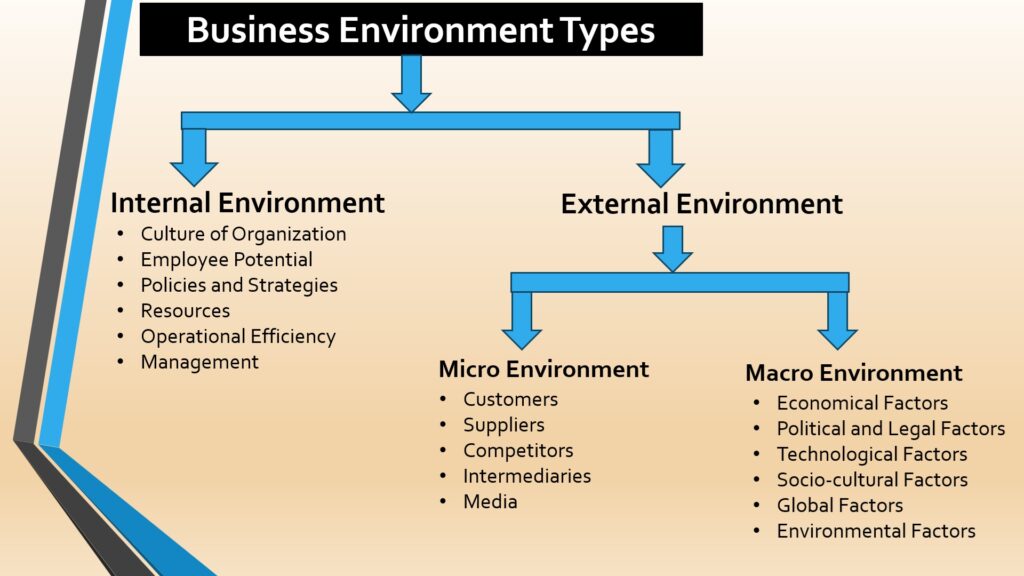Types of Business Environment
The study of the Business environment is an essential part of any business organization. A business environment study enables the organization to determine its strengths and weaknesses. Through this study, the business organization can enhance its strengths and reduce or eliminate its weaknesses. The strategy formulation can effectively be done through the study of a business environment. The business environment can broadly be classified as
Internal environment
External environment
Macro Environment
Micro Environment

The Internal Environment
Internal Business environment consist of following factors
- Organization Culture
- Employees
- Strategies and Policies
- Resources
- Management
- Operational Efficiency
Organization Culture
Organizational culture is under the organization’s control as employees and organization policies form the organization’s culture. The culture can be changed or improved by making changes in rules, policies, and employees in the organization.
Every organization has its own culture which can influence the performance of employees. Enhancing or motivating the employees’ performances may be favorable or unfavorable. Organizational culture is formed by the way the employees work, interact, and execute various activities in the organization. Organizational policies and rules can make the culture more effective.
Employees
Employees belong to the internal environment as it can be controlled by the organization. Organizations can appoint experienced and potential employees or make the potential employees through training and development and effective leadership.
Employees of any organization are the organization’s strength and employees are the only resource in the organization who can create an effective and positive business environment.
Strategies and Policies.
Strategies and policies are implemented in organizations for purpose but slightly different purposes. Strategies are made for specific purposes and implemented for a specific period whereas the policies are implemented forever for a long period to create an organization’s favourable culture.
Strategies and policies are made by the organization itself hence these are under the control of the organization. Those factors that are under the control of the organization belong to the internal environment.
Example
The marketing strategy of Jio in India contributed to increasing the market. The pricing strategy of Jio in India has attracted customers to subscribe to the Jio Telecommunication services
Only Experienced Software Engineers are appointed at MNC IT Companies. Freshers are not selected. This is the HR Policy of that company that sets the criteria for hiring specific employees.
Resources
Resources consist of Human resources, financial resources, Management, and Technology. These resources are utilized effectively by the organization.
Resources of the company always need to be utilized effectively and properly so that the Excellency in the execution of all the activities can be done and the purpose can be achieved easily.
The human resources of any organization ensures the potential employees who strive to achieve the organizational goal with optimum utilization of available other resources. Every resource is interlinked and interdependent with each other. Such as financial resources can ensure fair remuneration to the employees which motivates the employees toward better performance.
Financial resources ensure the availability of advanced technology and required physical resources so that the manufacturing or delivery of the product or the services can be done with good quality that meets the customer’s expectations.
The organization can utilize the employee’s potential and management effectively or ineffectively. Hence these factors or resources are under the control of the organization and belong to the internal environment.
Management
Management practices belong to the different functional areas of business organization such as marketing management financial management human resource management production and operation management.
These functional areas are executed by the organization itself. Hence they are under the control of the organization. As the management is under the control of the organization they belong to the internal environment.
Management practices of any business organization ensure the success and growth of the business organization. Management can be effective or ineffective depending upon the way the company is implementing the management practices. Effective marketing management practices ensure the increase of sales and revenue whereas effective production and operations management ensures the quality of the product that meets the customer’s expectations. If both or all the functional areas are executed effectively with the cooperation of each other then customer satisfaction can be achieved which leads to increased revenue through sales.
Examples
The functional area of human resource management of any organization plays with important role in making available the potential staff that ensures the Excellency in the execution of all the business activities.
Marketing management consists of various activities such as advertising selling management distribution supply chain customer relationship management which can Identify anticipate and satisfy customers.
Operational Efficiency
The operational efficiency of any company indicates how well the organization is utilizing its resources and management. The operational efficiency of any company always focuses on Excellency in the execution of all the activities of all the functional areas of the organization such as Excellency in the marketing management practices excellency in the human resource management practices, Excellency in the production and operations management practices, etc.
Example
The company has potential employees in all the departments but their performance is not as per the expectation or it has to be. That means the company is not utilizing its human resources properly or effectively if a company with the existing potential staff achieves the objectives higher targets and growth of the company then we can say the operational efficiency of the company is higher.
Marketing management functional area in which various activities such as promotion of the brand distribution supply chain management segmentation customer relationship management and many activities are executed to satisfy the customers and retain them for longer. Time. Higher efficiency and higher operational representation of the company ensures these activities execute and meet the customer’s expectations so that the customers are retained for a longer period And contribute to higher revenue for the company.
Operational Efficiency of the company depends upon the way the company is implementing its policies strategies and all the functional areas activities properly and effectively. Hence all of these are under the control of the business organization and R belongs to the internal environment of the business.
External Environment
The external environment of the business is beyond the control of the business organization and is made up of the factors that are influencing the business but the company cannot control these factors. The external environment of the business can broadly be categorized into macro environment and microenvironment.
The macro environment of the business consists of factors that are at the national level and international level whereas the micro environment of the business consists of factors that are very close to the business organization. All of these factors have much more influence on the business organization but the business organization cannot make some changes or control these factors in spite of the organization can formulation the strategies and policies according to these factors. Following are the various factors belong to the external environment according to the macro environment and microenvironment.
External Environment
Macro environment.
Economic Factors
Political and Legal Factors
Socio-Cultural Factors
Technological Factors
Global Factors
Environmental Factors(Natural)
Microenvironment
Customers
Suppliers
Competitors
Intermediaries
Public(Media)

